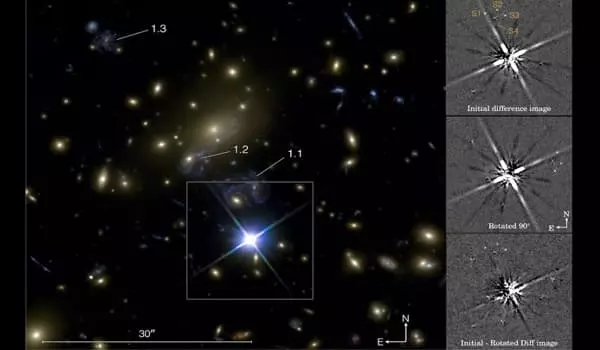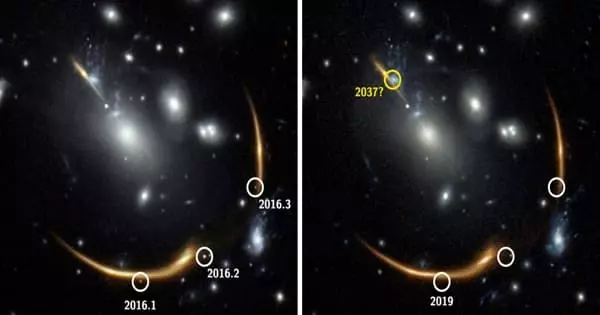A massive amount of gravity from a cluster of distant galaxies bends space so much that light from them is bent and emitted in multiple directions. The University of Copenhagen astronomers were able to observe the same exploding star in three different locations in the heavens thanks to the “gravitational lensing” effect. They believe that by 2037, a fourth image of the same explosion will appear in the sky. The study, which was recently published in the journal Nature Astronomy, offers an once-in-a-lifetime opportunity to investigate not only the supernova itself, but also the expansion of our universe.
One of the most fascinating aspects of Einstein’s famous theory of relativity is that gravity is now described as a “curvature” of space itself, rather than as a force. The curvature of space caused by heavy objects not only causes planets to spin around stars, but it can also bend light beam orbits.
Galaxy clusters, which are made up of hundreds or thousands of galaxies, are the heaviest structures in the universe, and they can bend light from distant galaxies behind them so much that they appear to be in a completely different location than they actually are. But that’s not all: light can travel in multiple directions around a galaxy cluster, allowing us to get lucky and see the same galaxy in different parts of the sky using a powerful telescope.
The “SN-Requiem” supernova can be seen in three of the galaxy’s four “mirrored images.” This has enabled astronomers to make an extraordinary prediction: The fourth image of the galaxy is roughly 21 years behind, which should allow us to see the supernova explode one more time, sometime around 2037.
Professor Gabriel Brammer
Supernova déjà-vu
Some paths around a galaxy cluster are longer than others and thus take longer. Another amazing consequence of relativity is that the slower the route, the stronger the gravity. This staggers the amount of time it takes for light to reach us, and thus the various images we see.
This wondrous effect has enabled a team of astronomers at the Cosmic Dawn Center, run by the Niels Bohr Institute at the University of Copenhagen and DTU Space at the Technical University of Denmark, and their international collaborators, to observe a single galaxy in no less than four different locations in the sky.
The Hubble Space Telescope’s infrared wavelength range was used for the observations. Researchers discovered three bright light sources in a background galaxy that were visible in a previous set of observations from 2016, but vanished when Hubble returned to the area in 2019. These three sources were revealed to be multiple images of a single star whose life ended in a massive explosion known as a supernova.

“Long before our own sun was formed, a single star exploded 10 billion years ago. The light from the explosion has just reached us” explains Cosmic Dawn Center Associate Professor Gabriel Brammer, who co-led the study with University of South Carolina Professor Steven Rodney.
The “SN-Requiem” supernova can be seen in three of the galaxy’s four “mirrored images.” Each image depicts a different stage in the development of the explosive supernova. It hasn’t yet exploded in the final two images. However, by investigating how galaxies are distributed within the galaxy cluster and how these images are distorted by curved space, it is possible to calculate how “delayed” these images are.
This has enabled astronomers to make an extraordinary prediction: “The fourth image of the galaxy is roughly 21 years behind, which should allow us to see the supernova explode one more time, sometime around 2037,” explains Gabriel Brammer.
Can teach us more about the universe
If we see the SN-Requiem explosion again in 2037, it will not only confirm our understanding of gravity, but it will also help to shed light on another cosmological mystery that has emerged in recent years, namely the expansion of our universe.
We know that the universe is expanding and that different methods allow us to determine how fast it is expanding. The issue is that, even when measurement uncertainties are taken into account, the various measurement methods do not all produce the same result. Could our observational techniques be flawed, or, more intriguingly, will we need to revise our fundamental physics and cosmology understandings?
“Over the next decade, the main earth-based observatories and international space organizations will prioritize understanding the structure of the universe. Future studies will cover a large portion of the sky and are expected to reveal dozens, if not hundreds, of rare gravitational lenses with supernovae like SN Requiem,” Brammer explains. “Accurate measurements of delays from such sources provide unique and reliable determinations of cosmic expansion and can even help reveal the properties of dark matter and dark energy.”
Dark matter and dark energy are the mysterious matter that is thought to make up 95 percent of our universe, despite the fact that we can only see 5 percent of it. The possibilities of gravitational lenses are exciting!





